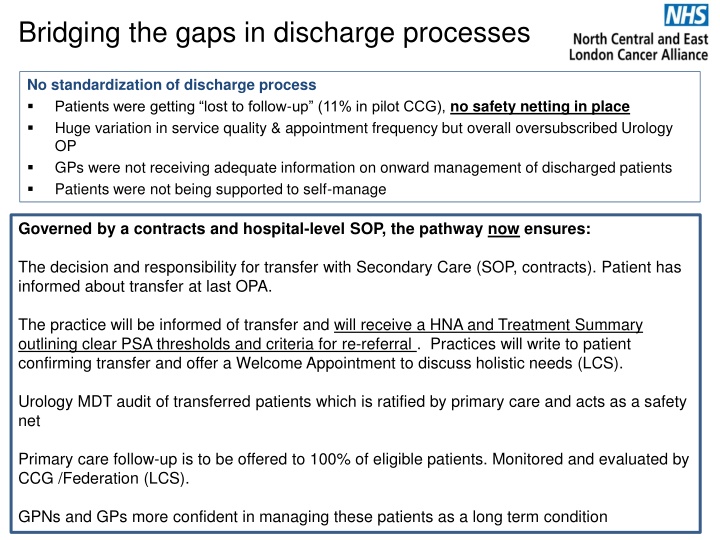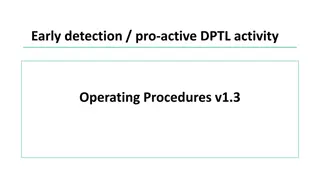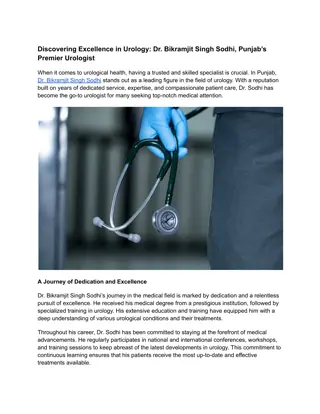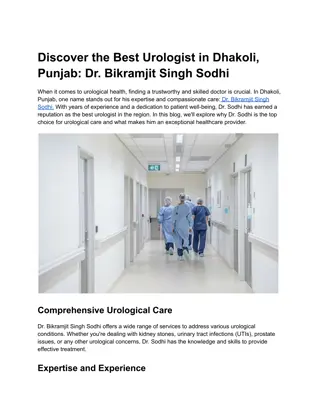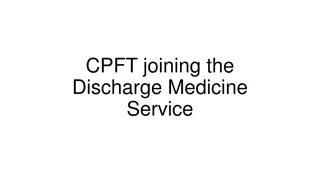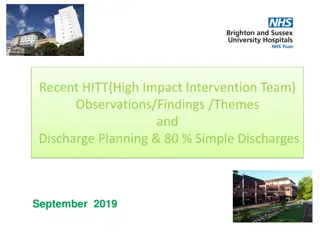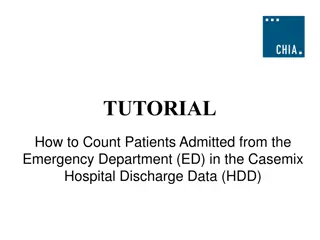Improving Discharge Processes for Urology Patients
Addressing gaps in discharge processes for urology patients led to the implementation of a standardized pathway ensuring proper communication, transfer protocols, and follow-up strategies. The pathway includes informed patient transfers, detailed communication with primary care, holistic needs assessments, stratified follow-up for stable prostate cancer patients, and active engagement of patients in their care. These measures aim to enhance patient support, reduce loss to follow-up, and improve overall management of discharged urology patients.
Download Presentation

Please find below an Image/Link to download the presentation.
The content on the website is provided AS IS for your information and personal use only. It may not be sold, licensed, or shared on other websites without obtaining consent from the author.If you encounter any issues during the download, it is possible that the publisher has removed the file from their server.
You are allowed to download the files provided on this website for personal or commercial use, subject to the condition that they are used lawfully. All files are the property of their respective owners.
The content on the website is provided AS IS for your information and personal use only. It may not be sold, licensed, or shared on other websites without obtaining consent from the author.
E N D
Presentation Transcript
Bridging the gaps in discharge processes No standardization of discharge process Patients were getting lost to follow-up (11% in pilot CCG), no safety netting in place Huge variation in service quality & appointment frequency but overall oversubscribed Urology OP GPs were not receiving adequate information on onward management of discharged patients Patients were not being supported to self-manage Governed by a contracts and hospital-level SOP, the pathway now ensures: The decision and responsibility for transfer with Secondary Care (SOP, contracts). Patient has informed about transfer at last OPA. The practice will be informed of transfer and will receive a HNA and Treatment Summary outlining clear PSA thresholds and criteria for re-referral . Practices will write to patient confirming transfer and offer a Welcome Appointment to discuss holistic needs (LCS). Urology MDT audit of transferred patients which is ratified by primary care and acts as a safety net Primary care follow-up is to be offered to 100% of eligible patients. Monitored and evaluated by CCG /Federation (LCS). GPNs and GPs more confident in managing these patients as a long term condition
Primary care stratified follow-up of stable prostate cancer patients
High level pathway appears not to have been localised enough for full implementation Diagnosis and Treatment End of treatment & living beyond cancer Refer patient (2WW) GP GP Support - Includes cancer care review within 6 months of diagnosis and referral back to specialist team, as required Secondary Entry onto cancer IT system and remote monitoring database Preparation of Treatment Summary and invitation to aftercare appointment Decision recorded on IT cancer system Admin Care Process referral Urgent referral back to secondary care as per triggers outlined on Treatment Summary Once PSA stable, Stratified follow-up OPA with clinician: HNA completed Treatment Summary reviewed and updated as required. Discharge letter completed HNA and TS given to patient and all documents sent to GP. Discharge to Primary Care for all eligible individuals. Treatment decision / Treatment / End of treatment clinical OPA with: discussion of future surveillance tests, support information and healthy living advice Treatment summary completed MDT GP Led Follow Up: Welcome appointment: with signposting or referral to relevant services. Annual holistic needs assessments are offered and PSA testing conducted every 6-12 months as per the individual s surveillance schedule Medical Investigation s and diagnosis Patient info. describes follow-up options Patien Patient actively engaged as a partner in their care throughout pathway. t Discuss follow- up options with patient Holistic Needs Assessment reviewed as needed Holistic Needs Assessment CNS Support service Health and well-being events AND additional support services (sexual functioning, continence, psychological/emotional support, rehab, diet and nutrition, physical activity, peer support) s
8 Key Points 1 2 Maintain a prostate cancer follow-up register with an active recall system Offer a welcome appointment to all newly transferred/discharged patients. Practice to start a holistic care plan and reviewed at subsequent follow-up consultations. Patients to be asked how they would like to receive their PSA results. Add all existing patients (those you have already following up) to the prostate cancer register. Contact the consultant is PSA thresholds are missing. Identify a named clinical lead (GP or Nurse) who should attend locally arranged training, complete a minimum 30 minute training session accredited by BMJ Learning and disseminate training material to other staff within the practice. Recommended modules available form your Cancer Lead GP or Macmillan GP. Signpost patient to resources to promote self-management of symptoms such as fatigue and incontinence as well as signposting to appropriate services to be made available for patients. Check PSA levels against patient specific normal ranges /parameters as per their Treatment Summary. Lab normal ranges may not reflect patient specific threshold. Inform patients of their specific PSA results according to patient s specifications. Refer back to the Urology team if a specialist review is required. Practices to advise patients about the referral and to inform them if they haven t received a clinic appointment within 14 days. Follow up any patient failing to make an appointment or failing to attend the review consultation. 3 4 5 6 7 8
